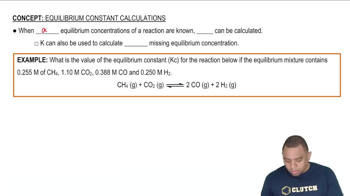Here are the essential concepts you must grasp in order to answer the question correctly.
Equilibrium Constant (Kc)
The equilibrium constant, Kc, quantifies the ratio of the concentrations of products to reactants at equilibrium for a given reaction at a specific temperature. A very small Kc value, such as 1.7 * 10^-56, indicates that the reaction favors the reactants significantly over the products, suggesting that at equilibrium, the concentration of products (in this case, O3) will be very low compared to the reactants (O2).
Recommended video:
Equilibrium Constant Expressions
Le Chatelier's Principle
Le Chatelier's Principle states that if a dynamic equilibrium is disturbed by changing the conditions, the system will adjust to counteract the change and restore a new equilibrium. In the context of the reaction involving O2 and O3, if the concentration of O2 is increased, the equilibrium will shift to produce more O3, but given the very low Kc, the amount of O3 produced will still be minimal.
Recommended video:
Calculating Equilibrium Concentrations
To find the equilibrium concentration of a species in a reaction, one can use the expression for Kc, which relates the concentrations of the products and reactants. For the reaction 3 O2(g) ⇌ 2 O3(g), the Kc expression is Kc = [O3]^2 / [O2]^3. By substituting the known concentration of O2 into this equation, one can solve for the equilibrium concentration of O3, which will be very small due to the low value of Kc.
Recommended video:
Equilibrium Constant Calculation
 Verified step by step guidance
Verified step by step guidance


